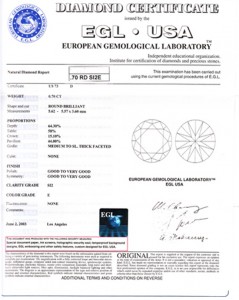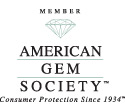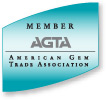Which diamond grading certificate is the best?
February 2nd, 2009 by James L. Sweaney, CGA, FGA. GGWe posted this about a year ago–with the tough economy, this insider information is more pertinent than ever, so we’ve tweaked the original post a bit and reposted.
In their quest for the best value, consumers looking to buy a diamond often make the mistake of giving equal weight to diamond grading certificates. Diamond grading certificates/reports are issued by various laboratories for the purpose of identifying, measuring and weighing, and grading a particular diamond. The different labs are generally payed by diamond merchants for this service.
One problem is that even though the various labs all use pretty much the grading system or language developed in the 1950’s by the Gemological Institue of America (GIA), they each have their own internal methods, standards and skill levels. Also, some of the labs are profit making and are closely affiliated with the firms for who they work–and this relationship is not always apparent to the ultimate consumer. The reports/certificates may look very similar, but the quality of the information can vary significantly.

Consumers tend to shop by comparing prices using the grades stated on grading certificates as their basis of comparison. The grading reports all look the same and have what appears to be the same information, so this seems like a safe way to shop prices.
One stone graded SI1 F by one grading laboratory sells for 30% less than a stone of similar weight graded SI1 F by another grading laboratory, so you buy the less expensive stone. You’d be stupid to spend more than you have to, right? The grading paper says it’s the same as these other stones, must be true, lots of dollars, good deal, right?
Wrong! We call this “Buying the Certificate.” The case history of an insurance appraisal we did of a 3-carat round diamond and ring shows just how much a diamond-grading certificate can affect the price of a diamond.
During the take-in procedure and before looking at the grading report, I had pre-graded this particular stone as SI2 clarity, H or possibly I color. The stone was nicely cut, but the inclusions within were positioned so that they reflected throughout the stone, much like a kaleidoscope. In diamond grading, we call this a “reflector” and usually deduct 1/2 to 1 clarity grade depending on the impact of the reflections. And the stone had a somewhat darkish look overall.
So I was really surprised when the client disclosed that he had purchased the stone as “colorless” (the range of D-F) and that it had a grading certificate from EGL showing the clarity as SI1 and the color as F. Turns out he had purchased the stone from a dealer in downtown LA who assured him that it was a really super deal at $35,000 for the ring and who gave him a “feel good” appraisal for $72,000.
My research of comparable items actively being marketed showed the current wholesale prices for 3 ct. round SI1 F diamonds graded by EGL labs ranged from $7,950 to $10,100 per carat and averaged about $9100 per carat. Multiply 3 cts x $9100, add 26% markup on the diamond, about $2000 for the 18K ring and voila! —My appraisal was for $36,500, within 4% of what he said he paid
A survey of well cut 3 ct round diamonds graded SI1 F by GIA averaged about $13,600 per carat—almost 50% more. I also checked prices for well-cut 3 ct rounds graded by GIA as SI2 H color (my original grading). What do you know – the price range of the 39 stones I checked was $7,350 to $10,080 per carat! Virtually the same price range as the EGL SI1 F graded stones.
The lesson is that the market knows the reality–diamonds are what they are, regardless of what a piece of paper says. My years as a professional diamond grader and diamond-grading supervisor at the Gemological Institute of America (GIA) told me that this stone should not be graded SI1 F. The marketplace confirmed what I knew to be true.
As sellers of diamonds, we at Mardon always recommend diamonds graded by GIA or AGS because we know the quality of their work. Their grading is the most consistent and the most conservative. These are the two labs most respected in the marketplace, period.
Moral of the story–When you buy a diamond, don’t make the mistake of buying the certificate. Don’t just look for the lowest price. Look at the stone, and if you can, compare it with a similar stone side by side. Most importantly, work with a diamond professional, preferably an experienced gemologist who can help you play the grading certificate game and win!







